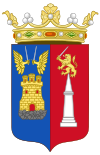Almansa
| Almansa | ||
|---|---|---|
| Municipality | ||
 |
||
|
||
 |
||
| Location in Spain | ||
| Coordinates: 38°51′N 1°05′W / 38.850°N 1.083°W | ||
| Country |
|
|
| Autonomous community | Castile-La Mancha | |
| Province | Albacete | |
| Comarca | Altiplanicie de Almansa | |
| Judicial district | Almansa | |
| Commonwealth | Monte Ibérico–Corredor de Almansa | |
| Government | ||
| • Mayor | Francisco J. Núñez Núñez (PP) | |
| Area | ||
| • Total | 531.91 km2 (205.37 sq mi) | |
| Elevation | 712 m (2,336 ft) | |
| Population (2015) | ||
| • Total | 24,837 | |
| • Density | 47/km2 (120/sq mi) | |
| Demonym(s) | Almanseños | |
| Time zone | CET (UTC+1) | |
| • Summer (DST) | CEST (UTC+2) | |
| Postal code | 02640 | |
| Dialing code | 967 | |
| Website | Official website | |
Almansa is a Spanish town and municipality in the province of Albacete, part of the autonomous community of Castile-La Mancha. The name «Almansa» stems from the Arabic المنصف («al-manṣaf») «half way of the road».The municipality borders with Alicante, Valencia and Murcia. Almansa is famous for its Moros y Cristianos festival from celebrated from the 1st to the 6th of May.
Almansa is built at the foot of a white limestone crag, which is surmounted by a Moorish castle, and rises abruptly in the midst of a fertile and irrigated plain. About 1 mile (1.6 km) south of the town centre stands an obelisk commemorating the Battle of Almansa fought there on the 25 April 1707 during the War of Spanish Succession, in which a French, Spanish and Irish army under the command of duke of Berwick, a natural son of James II, routed the allied British, Portuguese and Spanish troops.
The Sierra del Mugrón is located within the Almansa city limits.
The main sightseeing attraction is the 14th-century Castle of Almansa.
There are other important monuments, such as:
8 km from the city is the reservoir of Almansa, built in 1584. This reservoir is the oldest one in Europe. 12 km from the city is the Sanctuary of Our Lady of Belen (17th century).
Two pilgrim routes on the Camino de Santiago meet in Almansa. From the south comes the Camino de la Lana and from the east, the Camino de Levante. The Camino de la Lana joins Alicante with Burgos, and the Camino de Levante joins Valencia with Zamora.
...
Wikipedia


